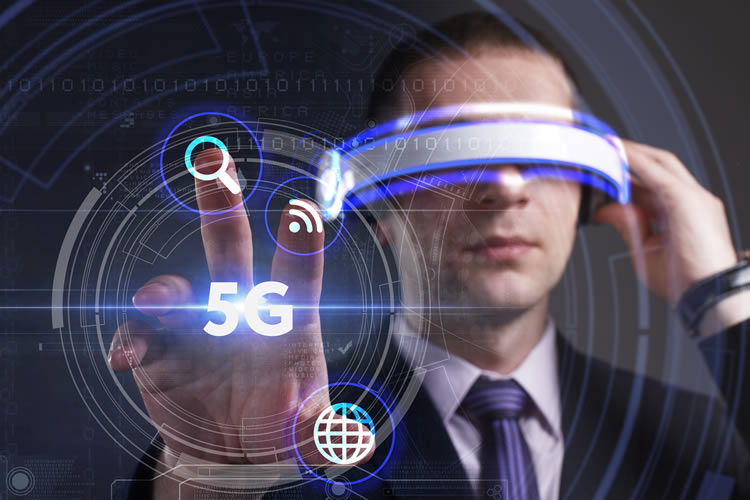
Updated: 26th November, 2018
Tomorrow’s augmented and virtual reality applications will lean heavily on a fully functioning 5G network.
It's no exaggeration to say that the future of augmented and virtual reality is dependent on a reliable 5G network.
We know that 5G will bring with it a massive increase in mobile network speed, capacity, and reliability. There will be many use cases for this, but VR and AR in particular are set to evolve to the next level.
What is VR and AR?
Virtual Reality, or VR, is the practice of embedding a user in a fully immersive three dimensional computer-simulated world, typically through the use of a specially constructed headset.
Augmented Reality, or AR, is built on similar technology to VR. Instead of creating a completely self-contained digital reality, however, it splices virtual elements into a real world view. By way of an example, consider the heads-up display (HUD) of a modern fighter jet. At the other end of the AR scale, think of the tiny monsters battling on your local park bench in Pokemon GO.
The early '90s saw the first major wave of virtual reality hype with the first widespread commercial releases of consumer headsets. This could be seen with a number of large, expensive VR arcade machines, though the experience proved too cumbersome and costly to break into the mainstream.
In recent years, both both VR and AR have experienced something of a resurgence thanks to advances in mobile and computer technology. The Facebook-owned Oculus Rift, the HTC Vive, and Sony’s PlayStation VR have all provided convincing and affordable VR experiences, while both Apple’s iOS and Google’s Android smartphone operating systems have spawned a range of AR and VR applications.
As a result, ABI Research estimates the total AR market will reach $114 billion by 2021, while the total VR market will reach $65 billion within the same timeframe.
What does 5G have to do with VR and AR?
Many experts within the industry believe that the arrival of the next generation of mobile network, widely referred to as 5G, will unlock the full potential of VR and AR technology.
As an October 2018 Qualcomm report outlined, both VR and AR require a cheaper, more capacious network with lower latency and more consistency if they’re to continue developing. In other words, they both need 5G.
The complex worlds and sophisticated input mechanisms of VR and AR experiences require a lot of data to be processed. This is fine for local applications, but if you want to feed in data remotely it can place a strain on a network. That’s particularly so if the user is on the move or away from a fixed internet connection.
Immersion is key to AR and particularly VR experiences, so a laggy or unreliable connection can prove ruinous. Indeed, in the worst case scenario, a jerky VR experience can make the user feel physically sick.
This is where 5G’s significantly faster speeds and lower latency will come to the fore. ABI Research anticipates that 5G will bring about “a 10X improvement in throughout, a 10X decrease in latency, a 100X improvement in traffic capacity, and a 100X improvement in network efficiency” over 4G.
5G is expected to enable VR devices to offload the intensive computational work they require to the cloud. Besides increasing the fidelity of VR experiences, this will enable those same devices to become much smaller and more wieldy.
The aforementioned quote comes from a 2017 Qualcomm-commissioned ABI Research white paper entitled ‘Augmented and Virtual Reality: The First Wave of 5G ‘Killer’ Apps’. This paper highlights the potential synergy between 5G and VR/AR technology.
ABI’s white paper list four potential use case scenarios:
- 1.The streaming of VR and particularly AR content to vehicles. It’s expected that autonomous and semi-autonomous vehicles will become the norm over the coming decade or so, which will open the possibility of AR and VR content to be streamed in to the car. This will require 5G’s additional bandwidth and mobility.
- 2.Live streaming a sporting event over social media, utilising VR to make the feed truly immersive. There will necessarily be a very high density of users within a confined space, which 5G should be able to handle.
- 3.Forthcoming video formats will be much more data-intensive than present examples thanks to VR and AR applications. The likes of interactive 6 degrees of freedom (6DoF) video, which allow you to move around within recorded videos, can require up to 10X the bitrate required for 4K video.
- 4.Increasing complexity in remote control devices. Added demand for the ability to control devices remotely, as well as the greater sophistication through haptic feedback in the so-called ‘Tactile Internet,’ will require much lower latency from a mobile network.
How will VR and AR drive 5G adoption?
In one vital way, VR and AR applications could actively drive 5G adoption in its early stages: video.
As we’ve mentioned already, the next generation of video formats will be much more data-intensive than current standards, necessitating a much better mobile network environment. Part of this will be down to new standards such as HDR (High Dynamic Range) and high frame rates of 90fps and above (which is essential for super-smooth slo-mo videos).
But VR applications like 360-degree video will necessitate higher resolutions of 8K and above, and stereoscopic video (which separates left and right eye views in VR) also requires additional bandwidth. Meanwhile, the 6DoF video mentioned above will add extra strain with its translational movement capabilities.
It will be the widespread use of such video formats among smartphone users that will place a great strain on even advanced 4G networks. What’s more, many envision the near-future introduction of a mainstream wearable AR device that’s designed to be worn all day, and is constantly connected to the internet. ABI Research anticipates that there will be 48 million such AR smart glasses in operation by 2021.
All together this will mean an exponential increase in data demands on our mobile networks, which will help push the adoption of 5G.
What are the latest developments in 5G AR/VR?
The provision of enhanced 4G network coverage with so-called Gigabit Class speed is already making network-assisted AR and VR applications more viable. However, it will take 5G and its ability to leverage more spectral bands and wider bandwidths for a truly high quality networked AR/VR experience.
This lack of a suitable supporting network to date is one possible explanation why AR and VR haven’t quite made the mainstream breakthrough that many had predicted. This was a key topic at the Mobile World Congress Shanghai event held in July 2018, where mobile network operators were urged to focus on potential AR/VR applications as a matter of priority.
“Cloud AR/VR calls for both a 100mbps data rate to support 2K HD videos, and 5–8 ms to avoid dizziness,” explained Huawei’s David Wang. “Such demands are perfectly in line with the features of eMBB [enhanced mobile broadband] services during initial 5G deployment. Huawei, therefore, believes that Cloud AR/VR will arise as the most typical 5G eMBB use case.”
To that end, the GSMA is expected to release a whitepaper in 2019 outlining how operators can monetise 5G AR/VR.
It seems certain network operators have already got the message. An April 2018 GlobalData report cited interviews with numerous industry players, and revealed the expectation that VRAR would be responsible for a 40% traffic increase by 2025.
To that end, Verizon has already made numerous VR/AR acquisitions, while South Korea’s SK Telecom is building its own AR/VR platform. AT&T and Orange are also making efforts in the virtual reality space.









